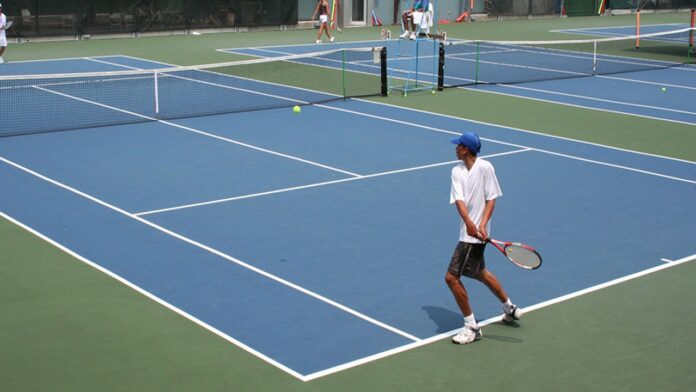Maintaining a well-kept and safe Tennis Court Floor | BackyardSportCourt is essential for optimal play and player enjoyment. Over time, even the most durable tennis court surfaces will start to show signs of wear and tear. Cracks, fading, and uneven textures can compromise the court’s performance and aesthetics. This is where tennis court resurfacing comes into play – a process that can revitalize your court and extend its lifespan. In this article, we’ll delve into when and how to tackle the task of tennis court resurfacing to ensure you’re always at the top of your game.
Signs It’s Time for Resurfacing
Every tennis court has a lifespan, and recognizing the signs of wear that indicate the need for resurfacing is crucial. Here are some key indicators that it’s time to consider a resurfacing project:
Cracks and Potholes
Cracks in the court surface, especially those that are widening, can affect ball bounce and player safety.
Fading and Discoloration
If the court’s vibrant colors have faded or the surface appears patchy and discolored, it’s time for a fresh coat.
Uneven Texture
Bumps and irregularities in the court can hinder player movement and even cause injuries.
Water Pooling
If water is pooling on the court after rain, it’s a sign that the surface’s drainage system might be compromised.
Loss of Grip
If the surface has become slippery, players’ traction can be compromised, leading to accidents.
The Resurfacing Process
Tennis court resurfacing is a multi-step process that requires careful planning and execution. Here’s a breakdown of the typical steps involved:
Assessment
Begin with a thorough inspection of the court’s condition. Identify areas of concern that need attention, whether it’s cracks, discoloration, or unevenness.
Cleaning
Before applying a new surface, the existing one needs to be thoroughly cleaned to ensure proper adhesion. Dirt, debris, and loose material should be removed.
Repair
Address cracks, potholes, and other surface imperfections. Fill in cracks and level out uneven areas to create a smooth base.
Resurfacing
Apply a new layer of acrylic coating to the court surface. This layer not only restores the court’s appearance but also enhances its playing characteristics.
Line Painting
Mark out the lines for tennis, pickleball, or other sports, ensuring precision and accuracy.
Drying Time
Allow sufficient time for the new surface to cure and dry properly. This is crucial for achieving the desired durability and performance.
Surface Finishing
Once the surface is dry, apply a final layer of specialized finish that enhances grip and provides the desired ball bounce.
Maintenance Tips
Regular maintenance is key to prolonging the lifespan of your newly resurfaced tennis court. Keep the surface clean from debris, ensure proper drainage, and conduct routine inspections.
Conclusion
Tennis court resurfacing is a significant investment that can breathe new life into your court, making it enjoyable for years to come. Recognizing the signs that it’s time for resurfacing and following the proper process are essential for achieving the best results. Whether you have a backyard tennis court or a professional sports facility, keeping the playing surface in top condition ensures a safe and satisfying experience for players of all skill levels. Remember, a well-maintained tennis court not only elevates your playing experience but also enhances the overall aesthetics of your sports facility. So, keep an eye out for the signs and be proactive in resurfacing your tennis court when the time is right.











